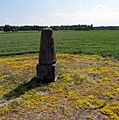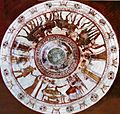List of World Heritage Sites in Eastern Europe facts for kids
The UNESCO (United Nations Educational, Scientific and Cultural Organization) helps protect special places around the world. These places are called World Heritage Sites. They are important for everyone to know about and keep safe because they have amazing history, culture, or nature.
Eastern Europe is home to 94 of these incredible sites. This part of Europe includes countries like Russia, Belarus, Poland, Czech Republic, Slovakia, Hungary, Ukraine, Moldova, Romania, and Bulgaria. Some sites are so big or important that they are shared between several countries. For example, the Primeval Beech Forests of the Carpathians and Other Regions of Europe are found in many countries, including Slovakia, Ukraine, and Bulgaria.
The very first sites from this region were chosen in 1978. These were Kraków's Historic Centre and the Wieliczka Salt Mine, both in Poland. Each year, UNESCO decides which new places to add to the list. They pick sites based on ten special rules, some for cultural importance and some for natural beauty. In Eastern Europe, most sites are cultural, meaning they show human history or art.
Sometimes, a site might be listed as "endangered" if something is threatening it. This means it needs extra help to be protected. Luckily, none of the sites in Eastern Europe are currently endangered, but some, like the Wieliczka Salt Mine and the Srebarna Nature Reserve, were in the past and are now safe again.
Contents
What Makes a Place a World Heritage Site?
UNESCO chooses World Heritage Sites because they have "outstanding universal value." This means they are so special that they matter to all of humanity, not just one country. There are different reasons a place can be chosen:
- Cultural Sites: These show human creativity, history, or traditions. Think of ancient cities, amazing buildings, or important historical events.
- Natural Sites: These are places with incredible natural beauty, unique landforms, or important plants and animals.
- Mixed Sites: Some places are special for both their culture and their nature.
Amazing Natural Wonders
Eastern Europe has some truly stunning natural World Heritage Sites. These places help us understand how nature works and protect important wildlife.
Ancient Forests and Caves
The Ancient and Primeval Beech Forests of the Carpathians and Other Regions of Europe are a huge natural site that spreads across many countries, including Slovakia, Ukraine, and Bulgaria. These forests are super old and help scientists study how beech trees have spread across the Northern Hemisphere. They also show us what natural forests look like without much human interference.
Another cool natural site is the Caves of Aggtelek Karst and Slovak Karst, shared by Slovakia and Hungary. This area has many caves with amazing rock formations.
Wild Rivers and Mountains
The Danube Delta in Romania is a massive wetland where the Danube River meets the Black Sea. It's a paradise for birds and other wildlife, with a huge variety of plants and animals living there. It's one of the largest and best-preserved deltas in Europe.
In Bulgaria, the Pirin National Park protects a beautiful mountain range. It's known for its stunning landscapes, alpine lakes, and diverse plant and animal life.
Russia is home to the Virgin Komi Forests, one of the largest untouched boreal forests in Europe. This vast area of trees, bogs, rivers, and lakes is like a natural laboratory, helping us learn about biodiversity in northern forests. The Western Caucasus in Russia is another wild mountain area, home to unique plants and animals, including the European bison.
Historic Cities and Castles
Many World Heritage Sites in Eastern Europe are old cities, grand castles, or important historical buildings that tell stories of the past.
Poland's Historic Gems
The Historic Centre of Kraków in Poland was one of the very first sites chosen. It was the center of Poland's political life for centuries. You can still see its medieval layout, grand market square, and beautiful old buildings.
The Castle of the Teutonic Order in Malbork is a huge brick castle in Poland. It was built by a group of crusader knights and was once the largest brick Gothic castle in the world. It's a fantastic example of a medieval fortress.
The Historic Centre of Warsaw is special because it was almost completely destroyed during World War II. But the people of Warsaw rebuilt it exactly as it was, showing amazing dedication to their history.
Czech Republic's Charming Towns
The Historic Centre of Prague in the Czech Republic is often called the "City of a Hundred Spires." It has beautiful architecture from different time periods, including stunning Baroque and neoclassical buildings. It's a city full of history and charm.
Other charming Czech towns include the Historic Centre of Český Krumlov and the Historic Centre of Telč, both known for their well-preserved medieval town centers and beautiful architecture.
Russia's Grand History
The Kremlin and Red Square, Moscow are at the heart of Russia's history. The Kremlin is an ancient fortress that was once home to princes and religious leaders. Red Square, with its famous St. Basil's Basilica, is a symbol of Russia.
The Historic Centre of Saint Petersburg and Related Groups of Monuments is known as the "Venice of the North" because of its many canals and bridges. This city was planned by Peter the Great and has grand palaces and buildings like the Hermitage Museum.
The Historic and Architectural Complex of the Kazan Kremlin is a unique site in Russia. It combines Muslim and Christian history, with ancient Tatar fortress remains alongside later Christian buildings.
Other Notable Cultural Sites
In Bulgaria, the Ancient City of Nessebar is located on a small peninsula in the Black Sea. It has a rich history with ruins from different eras, including ancient Greek, Roman, and Byzantine times.
The Architectural, Residential and Cultural Complex of the Radziwill Family at Nesvizh in Belarus is a beautiful palace and park complex that belonged to a powerful noble family. It shows the grand lifestyle of European aristocrats.
Romania has the Dacian Fortresses of the Orastie Mountains, which were important strongholds of the ancient Dacian people before the Roman Empire. The capital, Sarmizegetusa Regia, was built high on a mountain.
Unique Churches and Monasteries
Many World Heritage Sites are religious buildings that are important for their art, architecture, or spiritual history.
Russian Orthodox Treasures
The Architectural Ensemble of the Trinity Sergius Lavra in Sergiev Posad is a working Orthodox monastery in Russia. It's famous for its beautiful churches and its history, including the tomb of Boris Godunov. It also once held the famous "Trinity" icon by Andrei Rublev.
The Church of the Ascension, Kolomenskoye near Moscow is a very early example of a traditional Russian wooden tent-roofed church built with stone and brick. It was built to celebrate the birth of Ivan the Terrible.
The Ensemble of the Ferapontov Monastery in northern Russia is known for its amazing wall paintings by Dionisy, a famous Russian artist from the 15th century.
Eastern European Churches
The Boyana Church in Bulgaria is famous for its incredible medieval frescoes, which are very well-preserved and show a high level of artistry.
In Romania, the Churches of Moldavia are known for their colorful frescoes painted on the outside walls of the churches. These paintings tell religious stories and are unique in their style.
The Wooden Churches of Maramureş in Romania and the Wooden Churches of the Slovak part of the Carpathian Mountain Area are amazing examples of traditional wooden architecture. These churches were built without nails and show incredible craftsmanship.
Some World Heritage Sites are so special that they cross borders and are shared by multiple countries.
The Curonian Spit is a long, narrow sand dune peninsula shared by Lithuania and Russia. It's a unique landscape that has been shaped by both nature and human efforts to protect it from erosion.
The Belovezhskaya Pushcha / Białowieża Forest is a huge ancient forest shared by Poland and Belarus. It's one of the last and largest remaining parts of the immense primeval forest that once covered the European Plain. It's home to many animals, including the European bison.
The Struve Geodetic Arc is a chain of survey points that stretches over 2,820 kilometers through ten countries, including Moldova, Russia, and Ukraine. These points were used in the 19th century to accurately measure the size and shape of the Earth, which was a huge scientific achievement.
Places with Important History
Some sites are recognized for their connection to very important, and sometimes difficult, parts of human history.
Auschwitz Birkenau, German Nazi Concentration and Extermination Camp (1940–1945) in Poland is a place that reminds us of the terrible events of World War II. It was the largest of the Nazi concentration and extermination camps. It stands as a powerful memorial to the millions of people who suffered and died there, and it teaches us about the importance of peace and human rights.
The Thracian Tomb of Kazanlak and the Thracian Tomb of Sveshtari in Bulgaria are ancient burial sites from the Thracian people. They contain amazing frescoes and sculptures that give us clues about this ancient civilization.
Images for kids



















































































